By Manish Puri
Even when scarred with multiple, dubious stains that were immune to the efforts of the finest dry cleaners, I soldiered on with my first ever pair of cream linen trousers – commissioned eight years ago at Graham Browne. However, eventually my outlay on beer and nice dinners exceeded the inlay in the back, and I had to accept that these were the strides of a distant echo of myself.
I spent all of 23 minutes mourning my loss before remembering that when God closes a door, he opens a tailor’s window wide enough for even my beer belly to squeeze through. Surely the logical step, the only thing that could help me move on, was to commission a replacement pair of trousers. But why stop there?
At first glance, a cream suit might seem a frivolous indulgence – only to be worn at events where there’s a cast iron guarantee that no blood will be shed and no drinks thrown (which rules out family gatherings and dates). But it’s undeniably a beautiful thing, plus one of its strengths as a suit lies in its versatility, given how successfully it can be broken into separates.
I was also enticed by the prospect of finding out how well a cream linen jacket could moonlight as a summer dinner jacket – something I might explore further in a future article.
With that settled, I elected to go for a double-breasted suit because I didn’t have a summer DB suit in my wardrobe. In fact the only DB suit I’ve ever had (bespoke or otherwise) is a recent commission from Taillour in a pinstripe flannel.
I was very pleased with how that suit had turned out, and given a cream suit has the potential to be a little bold, I figured to myself it was smart to avoid more unknown variables: stick with a maker whose style I was already familiar, comfortable, and (most importantly) happy with.
I won’t retread the specifics of Taillour’s process, quality or fit – these are well covered in Simon’s reviews of his two commissions. However, I will echo what Simon said in his introductory piece, which is that Fred Nieddu (the head cutter) is “open to almost any idea”. The first discussion is always very organic and fluid – my somewhat disorganised thoughts on what I want smoothly translated into a drawing whipped up extemporaneously by Fred (below).
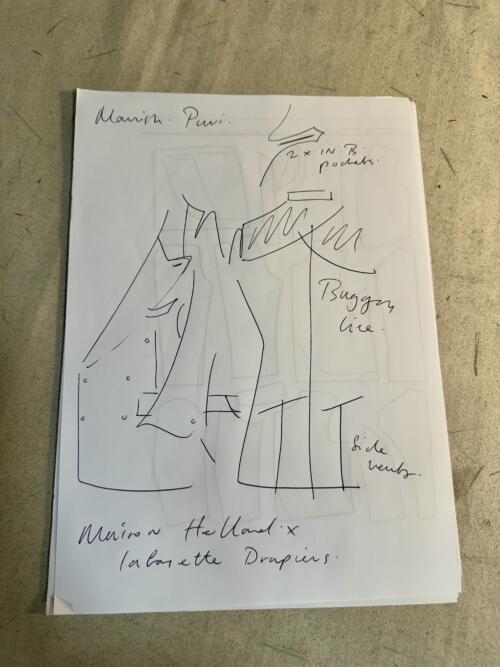
Having observed how I fussed and fidgeted when an earlier single-breasted Taillour jacket was cut close to my body, Fred and I agreed on more generous proportions for my winter DB. An extended shoulder, fuller chest, broad lapels with a bit of belly, more room through the back, straighter trousers. Soft classical: English shape and drape in union with Italian ease and comfort.
This was the template we followed for my cream suit, and it’s something Fred himself observed as becoming “more and more common in what we’re doing”, going on to say, “it’s about as soft a style you’re likely to find in London, without going to a purely Italian-oriented maker such as Speciale [the Florentine-trained tailors in West London]”.
Interestingly, the canvas was cut on the bias (i.e. at a 45 degree angle to the weave) – a technique used to accentuate its natural softness and stretch, promoting better shape around the body- and was padded in an unusual manner, as one of Fred’s tailors Josh Tarimo explains:
“It’s based on an old Italian style we’ve dubbed a ‘swirl’ canvas (below) where, instead of doing directional pad stitch in a linear pattern, it’s padded in a circular pattern and motion radiating outwards from around the nipple. It gives a lot of drape through the chest and will soften with the body over time, and that’s ultimately what we want: to not force the cloth too much and let it do what it wants to do.”
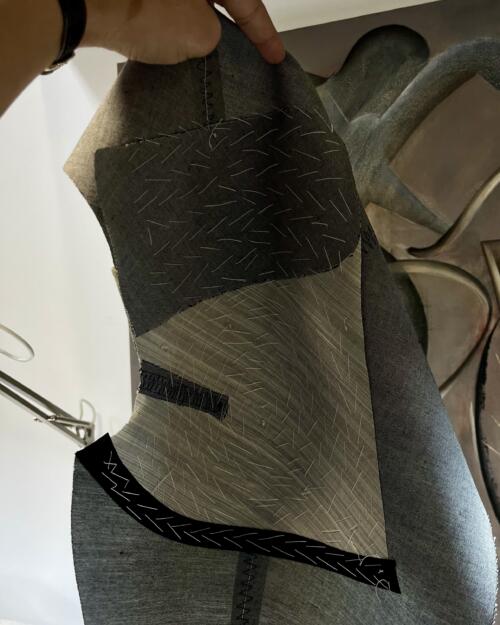
The result ranks among my favourite commissions ever. Bespoke’s base appeal is the promise of a superior fit and plentiful choice, but its siren call rests in the prospect of developing and refining your own sartorial identity. It’s simultaneously alluring and fraught with danger.
My previous commissions, as loved as they are, are stricter adherents to a house style or pre-defined visual template. This suit (and its flannel sibling) by contrast, are first steps towards exploring what that identity might be.
Of course, I’m a long way from realising it, and some seasoned veterans of bespoke will tell me that ambition is a chimaera – the more your vocabulary expands, the more you want to say – but, with a skilled and willing collaborator such as Fred, it’s bloody fun trying.
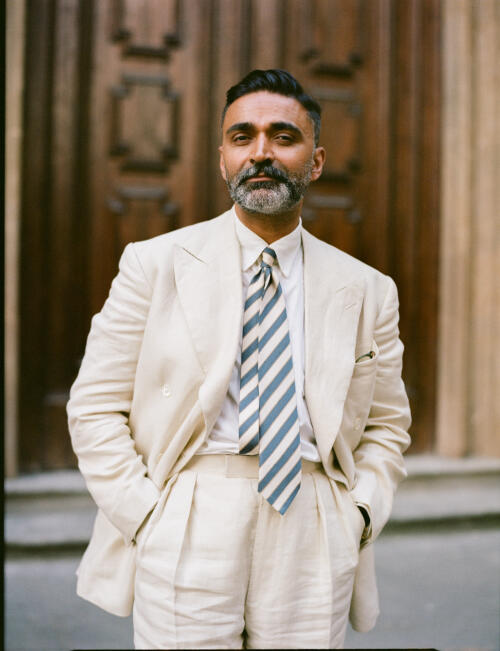
Having worn the suit a few times, there’s one minor stylistic point that I remain unsure of: the size of the collar – the piece that connects the two lapels around the neck. To my eyes, it seems a little large, almost swallowing the peak of the lapel whole. I’ve mentioned it to a few friends who’ve seen me in the suit, and they all say the same thing: I hadn’t noticed it, I’m not sure it is too big, but I kind of see what you mean.
My complaint here puts me in mind of something Frasier Crane tells his brother Niles after they judge a perfect meal to be marred by the absence of an outstanding cognac on the restaurant’s carte de digestif: What is the one thing better than an exquisite meal? An exquisite meal with one tiny flaw we can pick at all night.
I’ve already spoken to Fred about it (the collar, not the Frasier episode) and it’s an easy fix. My general stance on alterations that aren’t related to a fundamental problem (which this clearly isn’t) is to wait-and-see. If it still bothers me next spring, I can get the collar a little more scooped out before the summer season, but it’s nice to give something the opportunity to grow on you – and perhaps one day I’ll look at the collar as one of the defining features of this suit.
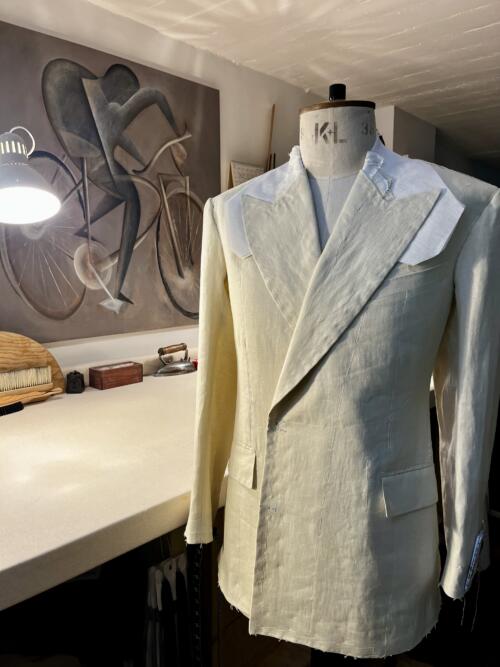
What’s more important to me is understanding why I hadn’t paid as much attention to the collar until the jacket was complete. I think it’s because a lot of tailors only attach a roughly shaped collar canvas (without cloth) for the first fitting or two, so the eye drifts toward the more ‘finished’ areas, which also happen to be the parts of the jacket which receive more attention naturally: the lapels, waist, buttoning point and length.
I’d stress that this isn’t unique to Taillour; I’ve trawled the PS archives and can see that Simon has had many similar fittings. It’s a necessary byproduct of the construction, as Fred explains: “If we need to drop the shoulder or change the fit around the neck, we’d potentially have to recut a new piece of cloth which could be quite wasteful. We do chalk in a collar line on the canvas, but I’m sympathetic to the customer because it does require a bit of imagination to visualise the final garment”.
Some may say that my realisation here smacks of being unobservant or unimaginative. I’d say this is simply part of the learning curve of bespoke – which includes accepting that, even with a patient tailor like Fred who affords you ample time at a fitting, the brain can’t always evaluate every aspect of a garment that is, by its nature, nuanced, complex and unique.
Experience (and imagination) helps of course, but I still find I often just need to take a suit out for a test drive to truly get a feel for it.
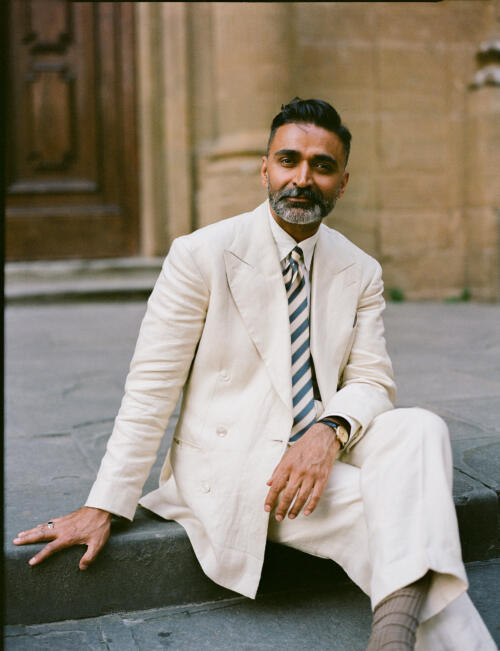
For the cloth, having previously made commissions in Irish linen, I was keen to try an Italian equivalent – something softer, with an ease and repose that befit the style of the suit.
I went for an ivory 12/13oz linen made by Maison Hellard – a French house that sources linen from Normandy to be woven in Italy.
I’ve been impressed for some time with Maison Hellard’s collections – specifically their taste level when it comes to colour palette and patterns – and I recently paid a visit to their maison near Pau in the southwest of France. So, if it’s all the same to you, I’ll keep my thoughts on how the cloth performed and what Maison Hellard are doing more generally for a future piece.
Manish is @the_daily_mirror on Instagram
Finished suit photography: Alex Natt
The other clothes are:
